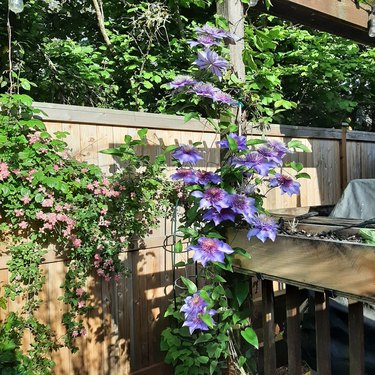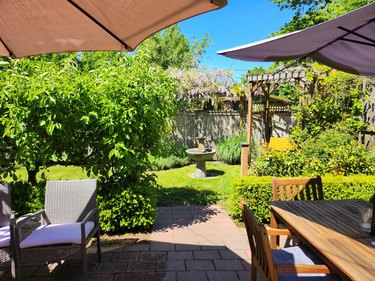
Intrigue and mystery. Those are not words we usually associate with a garden, but they can be. If your yard feels a little tired with a bland stretch of lawn along with shrubs and trees at the edges, do a redesign and bring the inside outside.
What does that mean? It means breaking your yard into separate "garden rooms" in the same way as your home.
Video of the Day
Video of the Day
Garden Room Design
Designing a space into separate garden rooms is a strategy that the pros use all the time. This means breaking up your outside space using either natural barriers (shrubs, trees, hedges, espaliers) or hardscape barriers (rock or brick walls, fences, ponds, trellises) — or more likely, a combination of both.
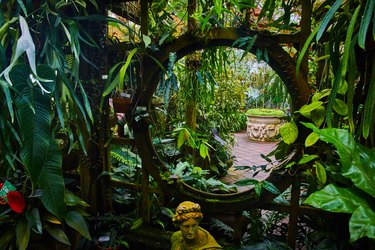
How does this create mystery? Because getting only a glimpse of a space that is around the corner, or barely visible through an espalier, or peeked at via an archway, or winding just out of sight when on a path — in other words, seeing just a sliver of what's ahead — provides an element of surprise and anticipation.
Further, an area visually secluded from the rest of the yard provides privacy and a sense of escape, famously articulated by Harold Nicolson, co-designer of the UK's famous Sissinghurst garden, well-known for its garden room design. Nicolson called each garden room a "succession of privacies: the forecourt, the first arch, the main court, the tower arch, the lawn, the orchard. All a series of escapes from the world, giving the impression of cumulative escape."
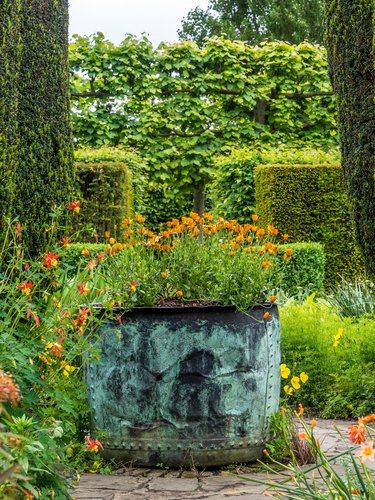
OK, OK, I know: Sissinghurst is a castle, for Pete's sake. I mean, really?
But a garden room design can actually work wonders in a small yard as well.
Breaking a yard into separate rooms can make the space appear larger. How?
Surprisingly, a small yard can actually appear larger when broken into rooms because the imagination is a powerful thing, and the eye is easily tricked when its vista is limited.
Expanding Inside to Outside
Think about your home's interior layout. You have a kitchen, which might be separated from the living room by just a counter. This could be analogous to a space outside separated from another area by a 2- or 3-foot-tall hedge or rock wall. Indoors, you might have a dining room where you can close the door to shut out the mess in the kitchen.
Outdoors, this could translate as a veggie garden behind a gate so you don't have to be reminded of your chores while you enjoy a meal on the patio. You might have a spot in your home where you like to sit and enjoy a view — you can, of course, make this happen outdoors as well.
Indoors, you emphasize comfort, utility, privacy, and beauty. Why not extend those ideas to your yard? If this appeals to you, read on.
Planning a Garden Room
Before taking action, do some planning and determine your goals. Here are some factors to consider.
Consider Your Plot
First things first. As with any garden design process, think about your yard and what you want to accomplish. What shape is your yard, and how big is it? Which areas get the most sun? If part of it is shaded by structures or big trees, you'll want to consider that in your design.
None of us regular peeps have estates where we can do whatever comes to mind. So, given your yard's limitations, what do you want to create, and what makes sense? You might want to retain a lawn for pets or children, or maybe you want somewhere to entertain or a quiet place to gaze at flowers or read a book.

For example, I have always wished for an outdoor sleeping nook, either on a deck or out in the yard somewhere private. You can carve out a private spot somewhere in the corner of your yard for just about anything.
Use What You Have
Consider whatever landscaping or outbuildings already exist. Unless you are looking for a major redo and you want to tear out shrubs and trees, you'll want to work around what you have.
And you might already have some lovely plantings. If so, use them! Many shrubs or trees can be recruited to be used when creating garden barriers.
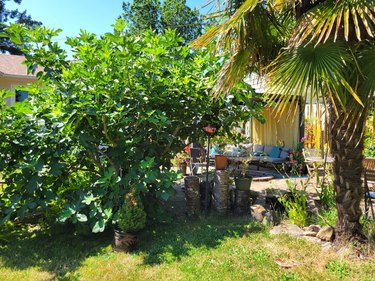
This garden started with a palm tree as an anchor. Adding pots, tall perennials, and a few shrubs transformed it into a "wall" separating the space from a large lawn.
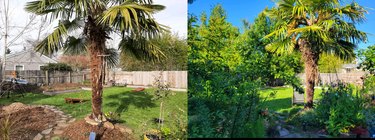
Think About Structure and Symmetry
Structure is an inherent part of a garden room approach and, indeed, most landscaping design. A garden grounded by specimen trees, hedges, rock or brick walls, or rows of shrubs or trees is satisfying to the eye. Otherwise, you may as well be gazing out at a field of wildflowers. So, structure is a given.
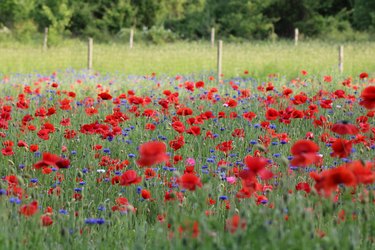
Then what about symmetry and balance? Some of the great gardens of the world incorporate symmetry, in which there might be a central axis from which lines originate, or evenly spaced shrubs or trees. You could have a walkway through the center of your property with a focal point as its target and then branch off into your rooms on either side.
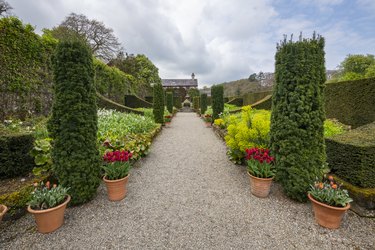
If you like this idea, just be careful not to overdo it, or your yard might end up feeling overly ponderous and formal.
Typical Garden Room Elements
There are a ton of ways to break up a yard to create a separate room. Here are some common elements.
Hedges and Espaliers
Hedges are ubiquitous as a living wall when creating a garden room, but you're dreaming if you have planted a hedgerow and hope it will do the trick in a year or two. The choicest plants to create hedges are boxwood, yew, and hornbeam. While these are marvelous for hedging in the long term, consider some faster-growing shrubs, such as privet or mock orange.
Traditionally, tall hedges completely separate garden rooms, but a 2-foot-high hedge complemented with a trellis can do the trick as well.
Espaliers also make gorgeous room dividers. Like hedges, they are not a quick fix, but they are worth the wait.
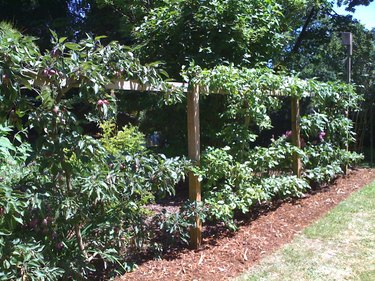
Rock or Brick Walls
Hardscape is your fast solution, but it can be expensive, and of course, it's pretty permanent. If you are sure of your design, it's a great option. You can soften its look by adding trellises and training up vines of clematis or climbing roses. Cascading plants are always lovely draped over a rock wall.
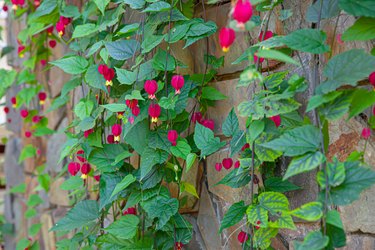
Flower Beds
A flower bed may seem impermanent, but it can grow quickly and provide a nice divider between rooms. Consider a combination of perennials complemented by annuals and you'll have a colorful wall in no time.
Choose some tall, structural plants to establish some height. Don't forget the multitude of ornamental grasses, many of which can grow quite tall and large enough to create a solid barrier between rooms.

Arbors and Trellises
A trellis goes up quickly, and there are multiple ways to build one. To create a free-standing trellis, you'll need to do some research and figure out how to anchor it well. Take a lesson from fence building because you might actually want to sink 4 by 4 posts into concrete — that would be the ultimate strong support.
Train annual vines up them and you'll have a summer screen in no time. A good strategy is to plant some perennial vines, some of which may even be evergreen in your area, and follow those up with annuals to provide a quick pop of height and color.
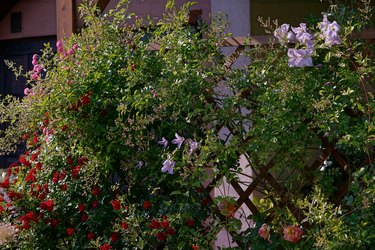
Water Features
Some water features, such as a pond or waterfall, can help define a space. These types of features are begging to be accessorized with various plants and flowers, many of which can be tall enough in height to create a room separator.
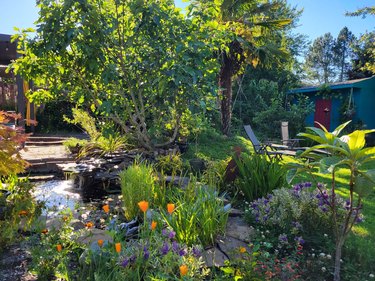
Large Planters
You can make these or purchase them. Depending on the look you're going for, a row of large pots with columnar trees (think Italian cypress) can be effective.
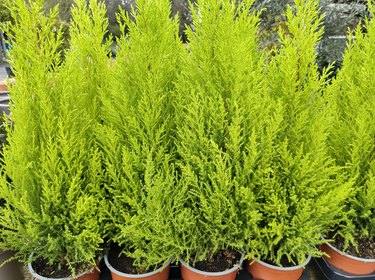
Pull It All Together With Pathways and Gates
Connect your rooms with pathways to convey a sense of a series of interconnected rooms. A path is particularly engaging when you can't see exactly where it leads.
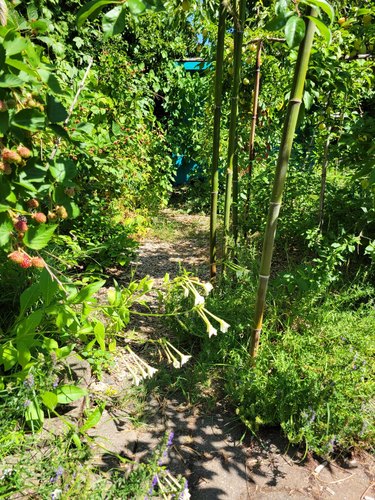
Development of a Garden Room Design
With any landscape redesign, it takes time to produce the planned result, and this may be especially true of a garden room design if you are adding some long-term structural plants, such as hedges or large shrubs.
I'll use my own yard as an example. We inherited a backyard mess with overgrown blackberries, a diseased apple tree, and a pile of weeds. This was in 2006.
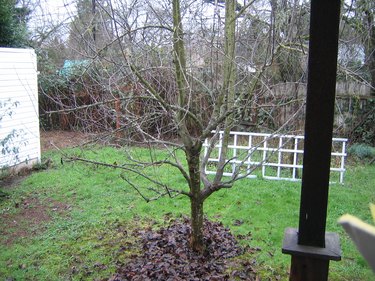
The primary design elements we incorporated included a brick patio and small lawn, a boxwood hedge, some espaliered trees to create a wall between rooms, various arbors (grape, rose, and wisteria), a fountain, and a path from the courtyard (previously the driveway) to the patio.
At Two Years
By 2008, we had some good structure going but just a glimpse of any rooms. We had not yet planted the hedge, but we had two young espaliered trees on either side of a walkway from the patio to a back lawn area.
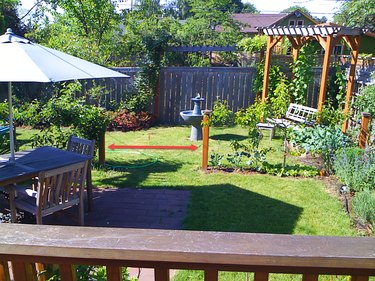
These trees took a few years to fill out. In the meantime, we added arbors and a lot of climbing vines, which were much faster and gave us more immediate satisfaction.
At Three Years
Our apple espalier was starting to take shape. At this point, we were starting to see our rooms appear. We added a hedge on the patio side of the two espaliered trees as well.
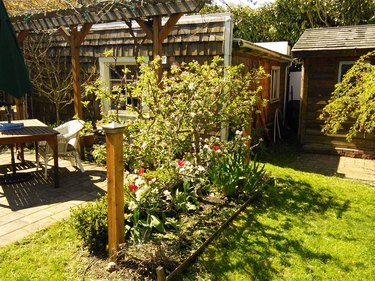
At Five Years
Five years in and it was clear that the pear espalier on the right was never going to reach potential, and each year, though we had high hopes, we were always disappointed.
But the hedge was gaining size, and everything was starting to provide the kind of structure we wanted.
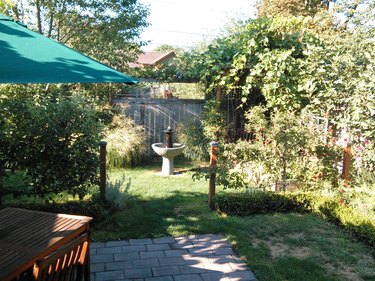
And the apple tree was a success! It was beginning to create a nice screen, so the garden room behind it was finally defined.
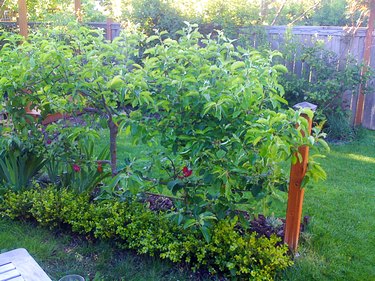
Ten Years and Counting
We did finally pull out the pear espalier but not soon enough, so if I have any advice when you have a clear failure, it's to do a makeover before you waste too much time. We decided not to replace it with another tree because we enjoy looking at the arbor and swing behind it, so it has only a half wall on that side now.

A lot has happened in the yard since 2006. We got a new fence on one side and had to tear out all the vines there and start over. We removed a lot of shrubs and replaced them, not always with success. We lost some beautiful plants but gained others.
Tip
Be flexible and don't be afraid to do makeovers. Garden design is half intention and half pure serendipity. Sometimes things work, but sometimes they just don't. When they don't, I say "tear it out!"
A garden is never static nor is it ever finished. Plants are growing and alive and are not accommodating enough to stay where we put them or to remain beautiful just for us. Further, our tastes and needs change. Our garden has gone through many, many iterations, and it will certainly go through many more.
Enjoy the Process
Garden design is an endeavor that can must be undertaken with hope — but also patience. We can't rush plants in their journey, but we can give them a good foundation and then see where they go. While I am generally in a big hurry to finish projects, and my nature is to be impatient, I find that sometimes, the daily observance of any small change in the garden is pleasure enough.
A famous saying, although its source is unknown, is "blessed is he who plants trees under whose shade he will never sit." If we take that adage into our own yards, maybe it will help us appreciate the process and not just wait for the end result.
That said, why the heck has my clematis not yet covered the arbor?
